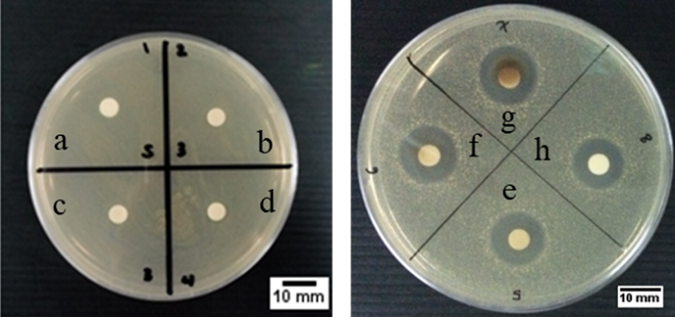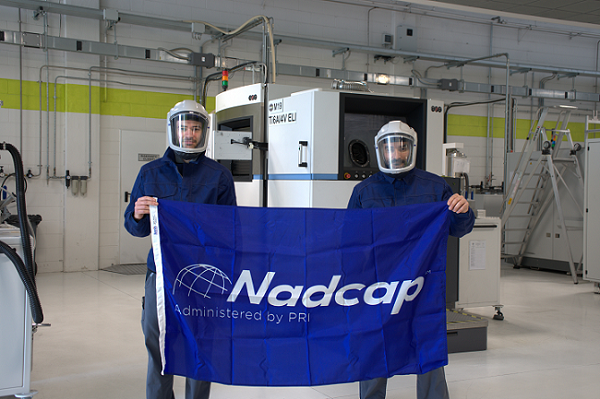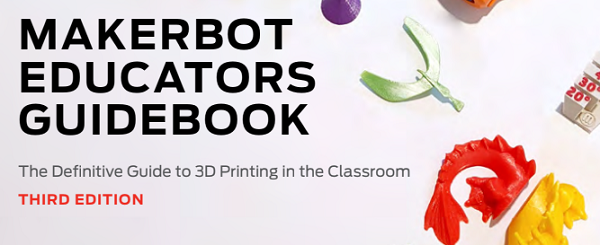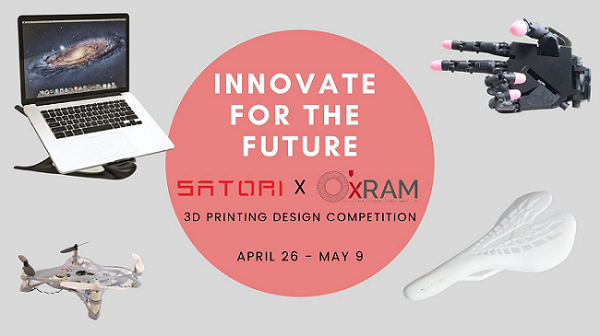3D Printing News Briefs, May 2, 2021: Intech; 3DPrinterOS & Octoprint; BEAMIT; ITB, ITK, & University of Manchester; Makerbot; Satori & Oxford University
We’re going to take care of business first in today’s 3D Printing News Briefs, and then move on to some research and education. Intech Additive Solutions is reporting multiple orders for its metal 3D printers, and 3DPrinterOS and Octoprint have announced a partnership. BEAMIT received an elite Nadcap Welding and AM accreditation, and a team of researchers are using sweet potatoes as fillers for some very specific 3D printed scaffolds. Finally, Makerbot has released the third edition of its Educators Guidebook, and Satori is hosting a 3D design competition with Oxford University’s Robotics and Additive Manufacturing Society.
Intech Additive Solutions Announce Multiple Sales
Bengaluru-based OEM Intech Additive Solutions Pvt Ltd. (Intech) is one of the first metal 3D printing service providers in India, and develops and manufactures laser powder bed fusion (LPBF) metal 3D printers. The company has announced that in the final quarter of 2020 fiscal year, it racked up multiple orders for its ‘Made in India’ iFusion metal 3D printers, which are integrated with its Build Processing software AMBuilder and parameter optimization software AMOptoMet, also developed in-house, to make an end-to-end metal AM solution. Intech sold a total of six metal 3D printers—its iFusion SF1 and iFusion LF1—with included software to five separate organizations, which are working with applications such as MIM parts for the aerospace and medical industries, and energy and energy infrastructure. All told, the company made $2 million in 3D printer sales.
“The positive results of Q4′ 20-21 has prompted us to accelerate our investment plans in hardware, software, and consultancy,” said Pradeep Nair, Vice President -Hardware Sales, Intech. “Our sales pipeline is highly promising. The market is prompting us to take a positive stand despite the looming COVID situation, which also gives us immense confidence to invest further. We are confident and determined to establish Intech as a global OEM. Our primary task is to create an innovative ecosystem to produce Metal AM products and services and embed them into mainstream manufacturing.”
OctoPrint Partnering Up with 3DPrinterOS
With so many extrusion-based 3D printers to choose from these days, you’d think that straightforward workflows would have been established, but unfortunately, it’s tough, as well as expensive, to integrate build software with 3D printers. Several years ago, open-source solution OctoPrint came on the scene, invented by German software engineer Gina Häußge, and is now widely used around the world as a 3D printer web interface. In order to fully integrate OctoPrint, many companies have to invest in onsite programming teams, but now that OctoPrint is partnering up with advanced manufacturing software solutions provider 3D Control Systems, the parent company of 3DPrinterOS, as a corporate sponsor, integration could get easier. The new 3DPrinterOS Software Development Kit (SDK) is now available as a free download, or you can pay for the premium version to access the advanced features.
John Dogru, President, Founder, and Chief Architect at 3DPrinterOS, said, “We are excited to help the community take 3D printers to market by making it easy to integrate open source software like OctoPrint, and help customers program all these different softwares to work exactly as they need them all to, in one place.”
BEAMIT Group Receives Elite Nadcap Welding Accreditation with Merit
Italy-based BEAMIT Group, which specializes in high-end metal 3D printed components for demanding industries such as automotive, energy, and industrial engineering, was recently audited by the Nadcap PRI Task Group, and received a prestigious accreditation for Nadcap Welding – Additive Manufacturing commodity, which is apparently the highest standard in AM you can get for serving the aerospace and aviation industries. The company says that the audit found no negative findings, and that this honor results from great teamwork, expertise in strategic project management, and several years worth of exacting preparation work. This is BEAMIT’s first accreditation among the world’s other top organizations, which shows that the company is ready for whatever its next big step may be.
“This is yet another important milestone for us in view of the industrialization of AM within the most demanding fields of application,” stated Michele Antolotti, General Manager, BEAMIT S.p.A. “Alignment of our quality management system and processes with Customer’s requirements is a top priority for leveraging the adoption of special processes in the AM value chain and scale up the reliability of the whole system.”
3D Printed Scaffolds Featuring Sweet Potatoes as Filler

The representative of antibacterial testing result using the disc diffusion method of (a) extract of baked Cilembu sweet potatoes, powder of: (b) Baked 1, (c) Baked 10, (d) Baked 100. Colloidal sample of: (e) Baked 1, (f) Baked 10, (g) Baked 100 and (h) Unbaked 10.
A collaborative team of researchers hailing from Indonesia’s Institut Teknologi Bandung (ITB) and Institut Teknologi Kalimantan (ITK), and the UK’s University of Manchester, published a paper about their work 3D printing anti-infection scaffolds out of electroactive biomaterials, using silver nanoparticles (AgNPs) as a possible filler due to their high conductivity, ability to promote bone healing, and antibacterial activity. However, as they explain, a toxic reducing agent that would inhibit the performance of biological scaffolds is needed to produce AgNPs, so they used the extract of Cilembu sweet potatoes to achieve green synthesis of them. In the paper, they studied the effect of different concentrations and baking on the antibacterial, chemical, electrical, and physical properties of their AgNPs, and even though they had some pretty promising results, the team did note that more investigation on biological assessment is needed.
“Transmission electron microscope (TEM) results revealed that the smallest particle size of AgNPs (9.95 ± 3.69 nm) with nodular morphology was obtained by utilization of baked extract and ten mM AgNO3. Polycaprolactone (PCL)/AgNPs scaffolds exhibited several enhancements compared to PCL scaffolds. Compressive strength was six times greater (3.88 ± 0.42 MPa), more hydrophilic (contact angle of 76.8 ± 1.7◦), conductive (2.3 ± 0.5 × 10−3 S/cm) and exhibited anti-bacterial properties against Staphylococcus aureus ATCC3658 (99.5% reduction of surviving bacteria),” they wrote in the abstract.
“This green synthesis approach together with the use of 3D printing opens a new route to manufacture AgNPs-based electroactive with improved anti-bacterial properties without utilization of any toxic organic solvents.”
You can read the full paper to learn more about this interesting research.
MakerBot Releases 3rd Edition of Educators Guidebook
In 2017, MakerBot first introduced a new MakerBot guidebook for teachers, together with its cloud-based My MakerBot 3D printing platform for classrooms. Earlier this month, the company announced the latest edition of the free and comprehensive MakerBot Educators Guidebook, which is available as a free download and comes with new design inspirations, project plans, industry examples, and other resources to help educators take their classroom 3D printing curriculum to the next level. While the first and second editions offered a 3D design and 3D printing primer, this one includes more advanced design ideas, complete with step-by-step instructions, and can be used as a complementary resource to the first two books. Important new chapters in the updated guidebook include “Get to Know Your MakerBot Printer,” about the main functionalities of the METHOD and SKETCH 3D printers, “Teachers’ Tricks of the Trade,” “Curriculum Project Ideas,” and more.
“There are so many ways that 3D printing can enhance the curriculum and help students engage in authentic learning. I introduced my students to different aspects and applications of 3D printing, and allowed them the opportunity to print out their own designs. Providing tiered support and guidance for students has transformed my classroom into an environment in which students can iterate on designs and solve problems using technology,” explained Beverly Owens, a co-author of the guidebook and an 11th grade chemistry teacher at Cleveland Early College High School.
“I want to be able to show my students that no matter the level at which you’re 3D printing, you can still learn and grow—you just need a little bit of confidence and practice. Going through the MakerBot Certification™ to become a MakerBot Operator and Curriculum Creator really solidified my confidence to help me see what I can do. With 3D printing, my students are only limited by the breadth of their imagination.”
Satori & OxRam Holding 3D Design Competition
UK 3D printer manufacturer Satori has partnered with Oxford University’s Robotics and Additive Manufacturing Society (OxRAM) to host an online 3D printing design competition, just for current students at Oxford. The goal is to design a 3D printed tool that can help solve a problem, whether it’s a societal challenge or just an everyday issue you’ve noticed. Designs have to be completed using a CAD modeling platform, and have dimensions of 27.8 x 15.6 x 30 cm. Submissions will be accepted through Sunday, May 9th, and Satori and OxRAM will choose their favorite design submissions to make up the top ten. Then, the public can vote for their favorite via social media May 10-14, and the top three winning designs will be printed on Satori’s new high-volume VL2800 resin 3D printer, and posted to the winners’ social media.
“As part of our mission to make 3D printing more accessible to the public, we believe 3D printing is not a standalone technology, but a tool to empower people’s creativity, whether you’ve already been using the tool or not. By launching this competition, we want to empower students’ creativity and send a positive message that in spite of education limitations imposed by COVID lockdown, our creativity and innovation can still thrive,” the Innovate for the Future competition page states.
Subscribe to Our Email Newsletter
Stay up-to-date on all the latest news from the 3D printing industry and receive information and offers from third party vendors.
You May Also Like
Further Understanding of 3D Printing Design at ADDITIV Design World
ADDITIV is back once again! This time, the virtual platform for additive manufacturing will be holding the first-ever edition of ADDITIV Design World on May 23rd from 9:00 AM –...
3D Printer Maker EVO-tech Reborn as NEVO3D — Once More With Feeling
EVO-tech was a 3D printing service and original equipment manufacturer established in 2013 and based in Schörfling am Attersee, Austria. The company produced high-quality material extrusion systems featuring linear bearings,...
3D Systems Brings 3D Printed PEEK Cranial Implant to the U.S. with FDA Clearance
For more than 10 years, 3D Systems (NYSE:DDD) has worked hand-in-hand with surgeons to plan over 150,000 patient-specific cases, and develop more than two million instruments and implants from its...
CDFAM Returns to Berlin for Second Annual Symposium
The second CDFAM Computational Design Symposium is scheduled for May 7-8, 2024, in Berlin, and will convene leading experts in computational design across all scales. Building upon the first event...




































